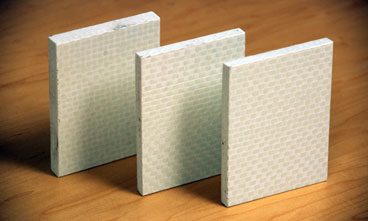American-made bullet proof DuPont™ Kevlar® fiber panels are mass-produced to exacting specifications with excellent quality assurance–but that doesn’t mean the panels are always installed improperly.
Kevlar® Installation Mistakes
If you want to back an existing counter with bullet proof Kevlar®, it might seem sufficient to give it a good coating of construction adhesive and clamp it in place–like adding a wood veneer. Provided that this counter only ever gets shot once, that might be sufficient. But when an armed robber starts pulling the trigger, it’s very rare for him to just fire a single shot. That layer of Kevlar® is going to pop off within the first two or three impacts. After that, the only thing between your workers and the bandit is plywood and paint.
If such a botched job seems unlikely, think again, says Total Security Solutions’ VP Jim Richards. “You wouldn’t believe the things I’ve seen. Whole systems installed backwards. That’s a problem that you run into, even with a professionally designed system, if the installation is left to someone inexperienced.”
Kevlar® panels need to be securely bolted into place, with the fasteners placed at corners and edges. Seams should be backed with batten strips (essentially an extra layer of Kevlar®) before dry-walling over the whole thing. “If someone does something stupid with the bolts–like putting in a few extra “reinforcing” fasteners in the middle of a sheet–“there’s weaknesses.”
It’s easy to compromise a system’s integrity if you approach this as though it’s a “cut ’til it fits” dry-walling job. 
Ideal Bullet Proof Kevlar® Panel Installation
In some retail applications and retrofits, where bullet proof Kevlar® is being applied to existing counters and walls, installers may choose to cut around electrical and data receptacles–rather than tearing them out and re-routing them. This certainly keeps costs down, but it has an impact on security, and is less than ideal. In such circumstances, it’s up to the facility owner–working with the bullet proof system designer and installer–to determine if the cost savings justifies the security impact.
Many government and military projects embody ideal practices for bullet proof Kevlar® construction. For example, although our border with Canada hasn’t been violently disputed in several centuries, the relative isolation and high symbolic value of US-Canada border patrol stations make them tempting targets for terrorists and malcontents. In these installations, bullet proof Kevlar® panels are directly integrated into every wall as it’s constructed, or mounted to the surface of existing walls and counters and then laminated with a veneer or other wall treatment, in essence creating a bullet proof skin.
The outside walls of these stations are built to Level 4 ballistic security–making them essentially “sniper-proof.” To accomplish this the bullet proof company installs a 1-3/8″-thick layer of Kevlar® panelling to the entire exterior of the building. This is then covered over with conventional siding. Because of the physical characteristics of Kevlar®, this Level 4 treatment is almost certain to stop everything from conventional rifles and sidearms to sub machine guns and assault rifles.
DuPont™ and Kevlar® are trademarks or registered trademarks of E.I. du Pont de Nemours and Company
